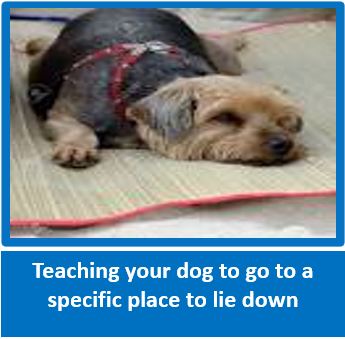
Please visit and LIKE our Facebook Page and share with family, friends and on your own Facebook page, and ask them to share further – it is only by working together and sharing knowledge and education that we can improve the lives of dogs and assist owners. We do not inundate you with posts – an average of 5 per week, and the odd Did You Know. Thank You!
Excessive Barking
By Dr. I. Dunbar – Courtesy of www.dogstardaily - wonderful website, more than worth a visit!
 Pic - Dog Barking Sound - Free Sound
Pic - Dog Barking Sound - Free Sound
Some dogs get extremely worked up when visitors ring the doorbell, or when dogs walk by the house. Some spaniels and terriers bark at the drop of a hat. And our good friend Larry Labrador will bark whenever a leaf falls from a tree three blocks away. Barking is as characteristically doggy as wagging a tail or burying a bone. It would be inane and inhumane to try to stop your dog from barking altogether: “You’ll never bark in this town again!” After all, some barking is extremely useful. My dogs are much more efficient than the doorbell and much more convincing than a burglar alarm. The goal then, it to teach dogs normally to be calm and quiet but to sound the alarm when intruders enter your property. The barking problem may be resolved to our advantage by management and education: first, immediately reduce the frequency of barking before we all go insane; and second, teach your dog to ‘Woof” and ‘Shush” on cue.
Reducing the Frequency of Barks
Dogs bark the most right after their owners leave home for the day. The easiest way to immediately reduce the woof-frequency is by exclusively feeding your dog from hollow chewtoys. Each evening weight out and moisten your dog’s kibble or raw diet for the following day. Squish the gooey food into hollow chewtoys (Kong products and sterilized bones) and put them in the freezer overnight. In the morning, give your dog some frozen stuffed chewtoys. Your dog will spend well over an hour extricating his breakfast from the chewtoys. And if your dog is busying himself with chewtoys, he will be lying down quietly! For detailed chewtoy-stuffing instructions, read our Chewing booklet).
Do not leave an excessive barker outdoors. Yard-bound dogs are exposed to many more disturbances and their barks more easily penetrate the neighbourhood. Leave your dog comfortably in a single room (away from the street) with a radio playing to mask outside disturbances. If you have been leaving your dog outside because he soils or destroys the house, housetrain and chewtoy train your dog so he can enjoy indoor comforts when you are away from home.
Teach ‘Woof” and “Shush” on Cue
It is easier to teach your dog to shush when he is calm and focused. Therefore, teaching your dog to ‘Woof” on cue is the first step in “Shush” training, thus enabling you to teach “Shush” at your convenience, and not at inconvenient times when the dog decides to bark. Moreover, teaching “Shush” is now much easier because your dog is not barking uncontrollably – barking was your idea!
Station an accomplice outside the front door. Say ‘Woof” (or “Speak” or “Alert”), which is the cue for your assistant to ring the bell. Praise your dog profusely when he barks (prompted by the doorbell); maybe even bark along with your dog. After a few good woofs, say “Shush” and then waggle a tasty food treat in front of his nose. Your dog will stop barking as soon as he sniffs the treat because it is impossible to sniff and woof simultaneously. Praise your dog as he sniffs quietly, and then offer the treat.
Repeat this routine a dozen or so times and your dog will learn to anticipate the doorbell ringing whenever you ask him to speak. Eventually your dog will bark after your request but before the doorbell rings, meaning that your dog has learned to bark on command. Similarly, your dog will learn to anticipate the likelihood of sniffables following your “Shush” request. You have then taught your dog to both speak and shush on cue.
Over repeated “Woof” and “Shush” trails, progressively increase the length of required shush-time before offering a food reward – at first just try two seconds, then three, then five, eight, twelve, twenty, and so on. By alternating instructions to woof and shush, the dog is praised and rewarding for barking on request and shushing on request.
Remember, always speak softly when instructing your dog to shush, and reinforce your dog’s silence with whisper-praise. The more softly you speak, the more your dog will be inclined to pay attention and listen (and therefore, not bark).
Teach Your Dog When to Bark
Invite a dozen people over for afternoon tea to teach your dog when, and when not, to bark. Instruct your visitors (some with dogs) to walk by the house a number of times before ringing the doorbell. When the first person walks by the house, it will take all of your attention to keep your dog shushed. But persevere: it will be easier when the same person walks by the second time, and again easier on the third pass by. Eventually your dog will habituate and will no longer alert to the same person’s presence in the street. Profusely praise your dog and offer treats for silent vigilance. Repeat reinforcement for quiet vigilance several times on subsequent passes by. But when the visitor starts up the garden path, eagerly and urgently say “Speak! Speak! “Speak” Praise your dog when he woofs, and then instruct him to sit and shush at the front door while you welcome the visitor. If your dog exuberantly barks and bounces at this point, simply wait until he sits and shushes and then praise and offer a treat. Have the visitor leave and come back a number of times. Eventually, your dog will greet him in silence. This procedure becomes easier with each new visitor. Your dog soon learns to watch passers-by in silence and give voice when they step on your property, but to sit and shush when they are invited indoors – a trained neighbourhood watchdog, which even non-dog-owning neighbours will welcome on the street where they live.
Reducing the Frequency of Barks
Dogs bark the most right after their owners leave home for the day. The easiest way to immediately reduce the woof-frequency is by exclusively feeding your dog from hollow chewtoys. Each evening weight out and moisten your dog’s kibble or raw diet for the following day. Squish the gooey food into hollow chewtoys (Kong products and sterilized bones) and put them in the freezer overnight. In the morning, give your dog some frozen stuffed chewtoys. Your dog will spend well over an hour extricating his breakfast from the chewtoys. And if your dog is busying himself with chewtoys, he will be lying down quietly! For detailed chewtoy-stuffing instructions, read our Chewing booklet).
Do not leave an excessive barker outdoors. Yard-bound dogs are exposed to many more disturbances and their barks more easily penetrate the neighbourhood. Leave your dog comfortably in a single room (away from the street) with a radio playing to mask outside disturbances. If you have been leaving your dog outside because he soils or destroys the house, housetrain and chewtoy train your dog so he can enjoy indoor comforts when you are away from home.
Teach ‘Woof” and “Shush” on Cue
It is easier to teach your dog to shush when he is calm and focused. Therefore, teaching your dog to ‘Woof” on cue is the first step in “Shush” training, thus enabling you to teach “Shush” at your convenience, and not at inconvenient times when the dog decides to bark. Moreover, teaching “Shush” is now much easier because your dog is not barking uncontrollably – barking was your idea!
Station an accomplice outside the front door. Say ‘Woof” (or “Speak” or “Alert”), which is the cue for your assistant to ring the bell. Praise your dog profusely when he barks (prompted by the doorbell); maybe even bark along with your dog. After a few good woofs, say “Shush” and then waggle a tasty food treat in front of his nose. Your dog will stop barking as soon as he sniffs the treat because it is impossible to sniff and woof simultaneously. Praise your dog as he sniffs quietly, and then offer the treat.
Repeat this routine a dozen or so times and your dog will learn to anticipate the doorbell ringing whenever you ask him to speak. Eventually your dog will bark after your request but before the doorbell rings, meaning that your dog has learned to bark on command. Similarly, your dog will learn to anticipate the likelihood of sniffables following your “Shush” request. You have then taught your dog to both speak and shush on cue.
Over repeated “Woof” and “Shush” trails, progressively increase the length of required shush-time before offering a food reward – at first just try two seconds, then three, then five, eight, twelve, twenty, and so on. By alternating instructions to woof and shush, the dog is praised and rewarding for barking on request and shushing on request.
Remember, always speak softly when instructing your dog to shush, and reinforce your dog’s silence with whisper-praise. The more softly you speak, the more your dog will be inclined to pay attention and listen (and therefore, not bark).
Teach Your Dog When to Bark
Invite a dozen people over for afternoon tea to teach your dog when, and when not, to bark. Instruct your visitors (some with dogs) to walk by the house a number of times before ringing the doorbell. When the first person walks by the house, it will take all of your attention to keep your dog shushed. But persevere: it will be easier when the same person walks by the second time, and again easier on the third pass by. Eventually your dog will habituate and will no longer alert to the same person’s presence in the street. Profusely praise your dog and offer treats for silent vigilance. Repeat reinforcement for quiet vigilance several times on subsequent passes by. But when the visitor starts up the garden path, eagerly and urgently say “Speak! Speak! “Speak” Praise your dog when he woofs, and then instruct him to sit and shush at the front door while you welcome the visitor. If your dog exuberantly barks and bounces at this point, simply wait until he sits and shushes and then praise and offer a treat. Have the visitor leave and come back a number of times. Eventually, your dog will greet him in silence. This procedure becomes easier with each new visitor. Your dog soon learns to watch passers-by in silence and give voice when they step on your property, but to sit and shush when they are invited indoors – a trained neighbourhood watchdog, which even non-dog-owning neighbours will welcome on the street where they live.




